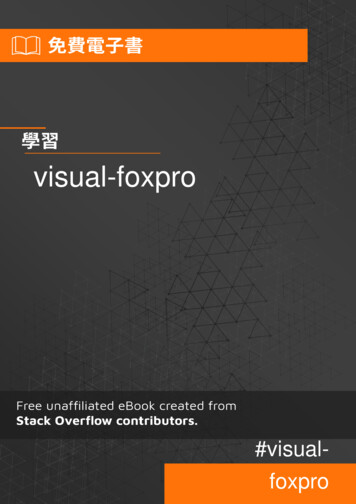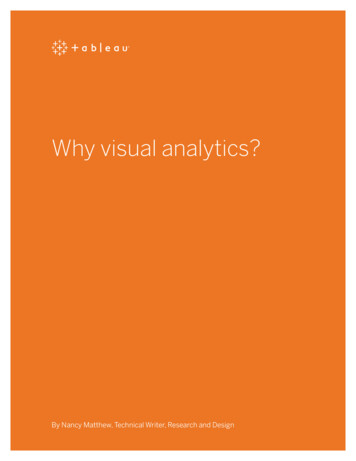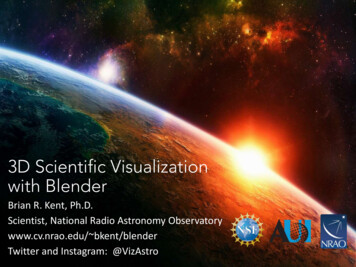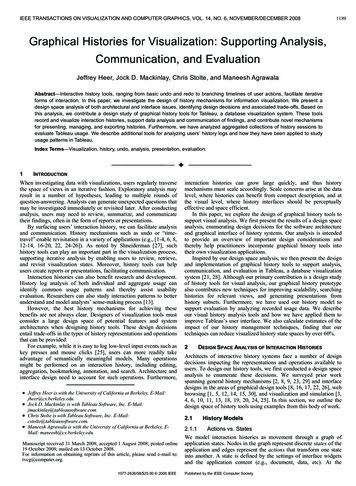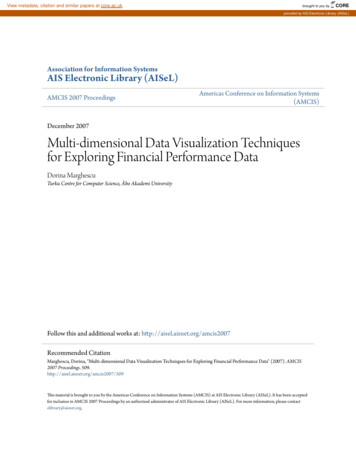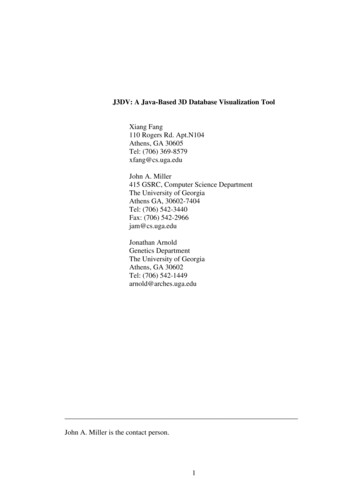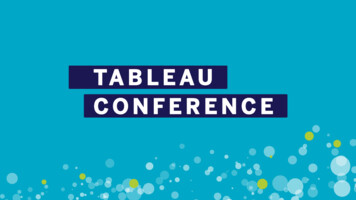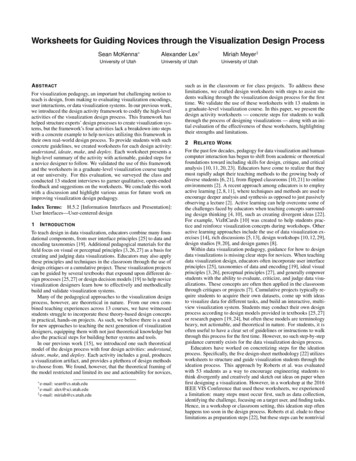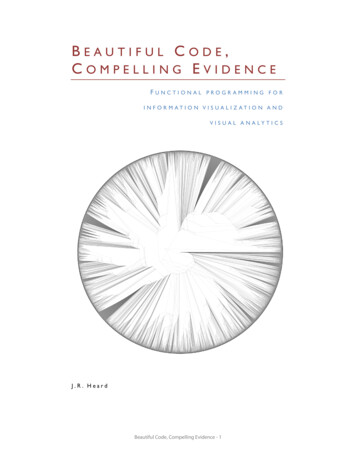
Transcription
BEAUTIFUL CODE,COMPELLING EVIDENCEFUNCTIONALPROGRAMMING FORI N F O R M AT I O N V I S U A L I Z AT I O N A N DV I S U A L A N A LY T I C SJ.R. HeardBeautiful Code, Compelling Evidence - 1
CO N T E N T SIntroduction .3Functional programming .3Visual analytics .3Preparations .4Getting organized .4Acquire .5Parse .6Filter .8Mine .8Represent . 10Refine. 12Interact . 12Reading Haskell for beginners . 14Haskell’s OpenGL interface. 19Haskell’s Cairo interface . 22Cairo Example : Sparklines . 23StructuredDataHandler.hs . 23Sparkline.hs . 24Main.hs . 24OpenGL Example : 3D Scatterplots . 25StructuredDataHanlder.hs . 25ProgramState.hs . 25Main.hs . 26An OpenGL visualization boilerplate . 29Main.hs . 29ProgramState.hs . 30StructuredDataHandler.hs . 31A Cairo Visualization Boilerplate . 32StructuredDataHandler.hs . 32Geometry.hs . 32Main.hs . 32Beautiful Code, Compelling Evidence - 2
IN T R O D U C T I O NVisualization programmers need a close-to-the-hardware, powerful 2D and 3D graphics toolkit tocreate applications that handle large amounts of data well. OpenGL is the most portable systemfor 3D graphics card programming, and thus is a common language for many visualizationapplications. Scott Dillard has said of the OpenGL graphics library bindings in Haskell:The library is fantastic. I don’t think it gets enough fanfare. The only otherGL API that rivals it is the C API itself. Most other languages provide ashoddy and incomplete interface to that, instead of an idiomaticinterpretation of the OpenGL specification. I can’t think of a singlelanguage, not even Python, whose OpenGL bindings come close.OpenGL is powerful, but it can also be more complicated than actually necessary. Forapplications involving 2D graphics, a low amount of interactivity, and a smaller amount of data, itwould be simpler not to bother with the video card and the rendering pipeline. Additionally,some visualizations are meant for print form. The Gnome Foundation’s Cairo 2D graphics toolkitis perfect for these applications. As luck would have it, Haskell also has an excellent binding toCairo.Three other things make Haskell ideally suited to information visualization and visual analytics: awell-thought out and extensible library of generic data structures, lazy evaluation, and theseparation of data transformation code from input/output inherent in a pure functionalprogramming language. Visualizations written in Haskell tend naturally to break up into portionsof reusable and visualization specific code. Thus, programs for visualization written in Haskellmaintain readability and reusability as well or better than Python, but do not suffer theperformance problems of an interpreted language.For much the same reason as Simon Peyton-Jones put together Tackling the Awkward Squad, Ihave put together these lecture notes. I hope these will bring a programmer interested invisualization and open to the aesthetic advantages of functional programming up to speed onboth topics.FU N C T I O N A LP R O G R A M M I N GA lazy functional programming language such as Haskell has practical effects that reduce theprogrammer’s concern over minutia that are irrelevant to the larger task at hand. Namely, itexpresses concurrency and takes advantage of parallelism without the programmer having tobother with barriers, threads, shared data, and IPC. It is capable of loading, unloading, processing,and storing complex data structures on demand without complicated support structures, caching,and loading schemes. It enforces separation of data transformation from data presentation. Itmakes debugging easier for a variety of reasons, one being type-safety and compiler-time stricttype checking. Finally, recursive data structures, such as graphs and trees, can be naturallyexpressed and traversed in functional programming languages without loss of efficiency.VI S U A LA N A L Y T I C STraditional scientific visualization is primarily concerned with showing structured data aboutevents or phenomena in the physical world. Earthquakes, supernovae, ocean currents, air quality,wind-tunnel tests, hydrodynamics; the models generated by scientific simulation or studies of ourenvironment or ourselves are the concern of scientific visualization.Beautiful Code, Compelling Evidence - 3
Information visualization and visual analytics are a bit different. Information visualizationconcerns itself with representing knowledge, facts, and the structures we use to order these facts.Graphs, charts, maps, diagrams, and infographics aim to illustrate clearly found relationships in amanner more efficient and more elucidating than, or complimentary to lengthy articles or papers.Visual analytics extends this notion to add the visual element to the process of data mining. Visualanalytics applications take raw data and apply transforms iteratively (or recursively), allowing theuser to see intermediate results of mining operations and direct the further application of miningtechniques based on the results.In this tutorial, we will focus on visual analytics and information visualization. Haskell’s abstractdata types map well to these applications. Once you master the simpler visualizations I present inthis tutorial, you can, on your own, apply Haskell’s wide array of prepackaged data structures tolook at the World Wide Web or the Facebook social network as a directed graph, at Amazonrankings as an ordered list, or other collections of data in sets or associative lists.PR E P A R A T I O N SBefore you start this tutorial, I recommend that you install GHC 6.8.3 1 , the latest version of theGlasgow Haskell Compiler (GHC) as of this writing, and while you’re at it, install GHC’s extralibspackage as well. This will contain all the OpenGL and GLUT bindings as well as quite a few otherthings you will find essential as you follow along. You will also want to get the Cairo library fromhttp://haskell.org/gtk2hs or from the tutorial’s website, r resources you may find helpful after going through this tutorial are: the OpenGLdocumentation for Haskell 2 , Yet Another Haskell Tutorial 3 , SPJ’s excellent Tackling the AwkwardSquad 4 essay on IO, concurrency, and exception handling, and finally the OpenGL blue or redbook (known as the OpenGL SuperBible and the OpenGL Reference, respectively).GE T T I N GO R G A N I Z E DBen Fry’s recent book Visualizing Data argues for a particular process to developing visualizations.I find it helpful in my own work, and therefore we’ll be using it here to structure our tutorial.Briefly, the process is:ACQUIRE PARSE FILTER MINE REPRESENT REFINE INTERACTAcquireObtain the raw data source, or a sample of the raw data source to construct your visualization.ParseCreate data structure that is natural to any of: the underlying data, the way you intend tovisualize the data, or the techniques you will use to mine the data.FilterSlice and dice, compress, and clean data until you have only the data you need to visualize.MineUse data mining techniques or summary statistics to find patterns in the gz2Beautiful Code, Compelling Evidence - 4
RepresentChoose a visual model to represent your data. Use a bottom-up approach. Start simply andwork up to more complex representations as needed.RefineImprove the representation until you have something you’re satisfied with.InteractAdd tools for the user to interact with the visualization, and if necessary, add tools for thevisualization to interact with the data stream.AC Q U I R EThe internet is full of data. Life is full of data. Science is full of data. The most persistent problemfor a data miner or a visualization professional is that people don’t understand why or when tovisualize data. The second most endemic problem is that people often don’t know what data theyhave.Information visualization is about presenting and supporting conclusions visually. Showingpatterns that are non-obvious, or associating data in ways that elucidate aspects of the data’sstructure. Visual analytics is about answering questions progressively. The goal is to give theresearcher a visual tool before s/he has come to the final conclusions about the data. Althoughinferences can’t be directly supported by visualization (the gestalt of scientific research today isthat statistics or proofs are required to back up conclusions, not pictures), the process of ascientist mining his or her data can be directed by these tools, especially when data structure getscomplex.Most people have trouble understanding what can be useful and usable to a visualization or datamining person, and so omit from their catalogue quite a lot of what they think won’t be helpful toyou. If you’re working with people rather than just finding your data on the internet, you’ll needto ask questions.The first question to ask someone interested in applying visual analytics, is, “What kinds ofquestions are you interested in answering?” You’ll get a general answer, and this won’t besufficient or directed enough to create a single visualization from, but hopefully from there youcan ask narrower and narrower questions until you have something you can bite off.After that, the question becomes “What’s the data I have to work with?” You’ll often get theanswer, “We don’t really have anything.” This is almost never the case. Create a mental prototypeof what the visualization that answers their question looks like. Think of what data you wouldneed to come up with to create the visualization. Ask for that. It’s much easier to acquire data ifyou can be specific in what you want. I once almost missed several gigabytes worth of useful textdocuments in a data mining job, because the owner of the documents didn’t think I could usethem because they weren’t in an SQL database. It took careful directed questioning to get themto realize what they had.Internet acquisition is somewhat easier. The web is its own enormous dataset, of course, as arethe various social networks out there. The US Government website, USGS, and CIA FactFinderhave interesting data to play around with to get your chops. If you’re creating visual analyticstools for a client, it’s often desirable to create mashups using their data as well as new data fromthe internet that is related in some way to what they’re doing.Beautiful Code, Compelling Evidence - 5
PA R S EThe raw data you have can be as complicated or as simple as you like, but I’m going to suggest acouple of basic structures for storing data on disk that can get you by in many (if not most)situations.First and foremost, there’s the regular delimited text file, stored in either row or column majorformat. If you have statistical or numerical data you are going to process without the need forexcessive querying, insertion, or deletion capability, this is an excellent format to put your datainto, even for databases of several gigabytes in size. Yes, it’s wasteful, but it’s easy to read intoHaskell, and usually easy to create from existing datasets. While tempting to build, a structureddatabase won’t save you anything unless you are going to use the same data repository outsideof the visualization.As an efficiency tip, it’s best to store chunks of data you intend to process as a set as lines on adisc, as Haskell can read these lines lazily. This is backwards from the way you normally work on aspreadsheet:NameSmithJonesCalhounRankField AgentField AgentDirectorSalary5000050500120000Service Years4521JonesField Agent505005CalhounDirector12000021Instead, you would store the data thusly:NameRankSalaryService YearsSmithField Agent500004Then the following function will read a text file stored in this format (tab delimited) and lay it outinto a dictionary where each row can be accessed by the name stored in the leftmost column:imports, aliases (1-3)import Data.List (foldl’)import qualified Data.ByteString.Lazy.Char8 as BStrimport qualified Data.Map as MapreadDatafile name doSplit all lines in the file. (6-7)sheet - (map (BStr.split ‘\t’) . BStr.lines) fmap BStr.readFile namereturn foldl’ go Map.empty sheetInsert them into the map (9)where go m (x:xs) Map.insert (BStr.unpack x) xs mTrust me – you’ll want to cut and paste that somewhere. It’s a useful function. What would you doif the file were, say, 16GB though? It certainly won’t fit all into memory. In a language like C orPython, you’d have to rewrite the function so that it didn’t read the entire file at once, but inHaskell you don’t. You can use this same function for any tab-delimited file of any size, becauseHaskell will only load the data as it is needed, and because the garbage collector will throw outthe data after it has been processed. That’s the beauty of laziness.What’s more, we’re using something called Lazy ByteStrings, which allow Haskell to readenormous amounts of data as quickly as it can be done in the best implemented C functions 5 .5See http://cgi.cse.unsw.edu.au/ dons/blog/2008/05/16#fast on writing reliably fast Haskell code.Beautiful Code, Compelling Evidence - 6
We’re talking about hundredths of a second difference between the two. You won’t write anentire visualization in Haskell only to have to port the code to C later for performance reasons.Because this is such a nice and versatile function, I’m going to say it makes sense to extend thenotion, for now, of using a regular delimited file to deal with hierarchically structured data. Yes,you may want to use XML to store your hierarchical data instead, and you are welcome to, but forthe sake of not adding APIs to the tutorial beyond OpenGL, It will do to create two files: one forthe linkage relationships between nodes, and one for the data at each node.Each row in the linkage file will contain a parent’s in the left column. The names of the childrenwill follow in the remaining columns. In the other file will be the data associated with each name,row by row, with the individual data elements appearing in columns, much like a traditionalspreadsheet organization. I have included an example file on the web for this kind of dataset, aswell as functions to turn it into a tree of data.There are other formats out there, of course, such as text, rich text, images, XML, and NetCDF (forregular scientific data), as well as packed binary formats of all different sorts. These formatsrequire special treatment, and we won’t be covering them in this tutorial.The function that I wrote earlier brings the data into Haskell’s heap as a map of raw ByteStrings.We need to get that into data we can use. If a datatype is not a string, but still fairly simple (that is,an integer or floating point number, an enumerated type, or anything else Haskell’s “read”function can handle), then a fairly simple function will suffice to turn a list of ByteStrings into a listof usable data:map applies its argument to allimport qualified Data.ByteString.Lazy.Char8 as BStrthe elements of a list. readturns a string into data.Bstr.unpack forces the data tobe read from disk.toData :: Read a [BStr.ByteString] - [a]toData map (read . Bstr.unpack)This function handles most cases, and it’s so short, it’s often more convenient to just write it inline.Any primitive except a string can be read by it, including any user defined types that are declaredto be “readable” (we’ll see how to do that in a minute). Creating Strings instead of ByteStrings isaccomplished by removing the read . from inside the parentheses (and changing theprototype) to toData :: [BStr.ByteString] - String . It’s amazing how many datatypesin Haskell are just readable by default: parenthesized tuples of readables are readable, as arebracketed lists of readables, record types of readables, and even recursive types containingreadables, making the simple delimited file much more powerful that it sounds on the surface:Declare a record type like a Cstruct.data RecordType Record { enum :: EnumeratedType, value :: [Float]Declare it readable/writable.[1,2,3,4,5,6] is readable.(One,Two ) is also readable.} deriving (Ord, Read, Show)let list [1,2,3,4,5,6]let tuple (One,Two,Three,Many 4,Many 5)Beautiful Code, Compelling Evidence - 7
Specifying instances of these declared types in your filedata EnumeratedType is as simple as writing instances of them like you wouldOnein your source code. Two Three Many IntThis line declares it readablederiving (Ord, Read, Show)There are of course situations where this basic format doesn’t suffice, and Haskell has tools forthose. Parsec is a library that comes with GHC by default which allows the user to constructparsers. Happy and Alex are Haskell tools similar to yacc and lex. Also well supported arevalidating and non-validating XML parsing at various DOM levels and HTML parsing. The learningof these tools, however, is left as an exercise for the reader.The structure that you end up with will likely be reflected by your visualization, and in the wayyou construct the visual representation. If you build a tree, you will obviously want to usevisualizations appropriate to a tree, but you will notice that you can construct the visualization bywalking the tree in some natural manner, such as a fold or a map.FI L T E ROne of the beautiful things about laziness in a programming language is how short this section ofthe tutorial can be. There are situations where you want to filter your data because it’s easier toconceptualize, but filtering is less a question of removal than it is structure. If your data isstructured properly, laziness will take care of not loading too much nor doing too muchprocessing.Only as much of your data structure as you actually use will ever be constructed, which can saveon time, and can allow you to write code more generally than you would in another language,because you don’t have to worry about unnecessary processing taking up time that could beused in your visualization. For record types, this means that only the individual fields of the recordthat are accessed will ever be constructed. For recursive types, such as trees and lists, only as farinto the structure as you descend will ever be constructed. Even in some instances arrays can belazy, evaluating elements only as they need to be evaluated.MI N EAside from the excellent implementation of OpenGL, mining is the reason to use Haskell forvisualization. The functions in Data.List, Data.Set, and Data.Map, in fact, give you most of thetools you need to mine data for visualizations. These three together support the following typesof operations on lists, unique item sets, and associative dictionaries (similar to Python or Perldictionaries, and known in Haskell as maps): Transformations (mapping)Reductions (folding)Programmed Construction (scans, accumulation, infinite lists, unfolding)Merging (zip, union, intersection, difference, and other common set operations)Extraction (sublists, splits, and partitions using indices or predicates)Search and LookupBeautiful Code, Compelling Evidence - 8
Most data mining functions can be reduced to combinations of mathematical functions appliedusing these operators. For example, clamping a value between a high point and a low point andmapping it to a value between [0,1], linearly is:PrototypeClamp the value from low to hi.Similar prototype, but note the last parameter andreturn are lists. map makes clamp work on lists.clamp1 :: Floating a a - a - a - aclamp1 lo hi val (val – lo) / (hi – lo)clamp :: Floating a a - a - [a] - [a]clamp lo hi map (clamp1 lo hi)The same thing can be done with Data.Map.map and Data.Set.map; these functions take,instead of lists as their arguments associative maps and unique item sets.The following function will compute the basic sample statistics: max, min, mean, variance, andsample standard deviation, often needed for performing normalization of the data, or comparingtwo different datasets:Prototypestats :: (Ord a, Floating a) [a] - (a,a,a,a,a,a)stats (x:xs) Data.List.foldl’ does a reduction with anfinish . foldl’ stats’ (x,x,x,x*x,1) xsaccumulator.The elemental step that adds thestats’ (mx,mn,s,ss,n) x ( max x mxelement x to the accumulator, min x mn, s x, ss x*x, n 1)Calculate the mean, the variance, andthe standard deviation from the valuesfinish (mx,mn,s,ss,n) (mx,mn,av,va,stdev,n)where av s/nstored in the accumulatorva (1/(n-1))*ss – (n/(n-1))*av*avstdev sqrt vaAnd finally, the next function will compute paired t-tests for two datasets, using the results of thefunction for computing sample statistics:pairedTTest left right Paired t testMax and min are never computed, because they’renever used. Yay laziness.(x1-x2) / sqrt ( s1**2/n1 s2**2/n2 )Where ( , ,x1, ,s1,n1) stats left( , ,x2, ,s2,n2) stats rightQuite a lot of the time, 99% of your mining process is simply getting the data into the structuresyou’re going to use. Much, then, can be inferred from building the data structures, and withHaskell’s lazy evaluation, you can specify as much as you want to be inferred without worryingabout its impact on the performance of the program. The inferences will only take place when theuser somehow needs them in the display.Beautiful Code, Compelling Evidence - 9
RE P R E S E N TSince I started programming visualizations in Haskell, I have developed a working pattern forbuilding the visual elements from scratch. It involves four steps:1.2.3.4.Create functions to transform your data structure into geometry.Write functions that render that geometry.Define the mutable state of the program.Create a master render function to render the scene, which is sensitive to OpenGL’sselection mode and renders only the selectable elements when called in this mode.The first thing you want to do is create some rules for turning your data into geometry. Generally,you will create some structure of 3D or 2D vectors and possibly material and color informationthat can be used later in the actual rendering function, or passed through another transformer todo something interesting to the geometry (like force-directed layout algorithms) beforerendering it. If your geometry’s structure mirrors the structure of your data, then you can traversethem together in further computations, making it easy to transform geometry based on the dataat hand. This is not as complicated as it sounds:DatNode would be a userdefined module.module DataGeometry whereimport DataNodeimport qualified Graphics.Rendering.OpenGL.GL as GLblack :: GL.Color4 Floatblack GL.Color4 0 0 0 1OpenGL geometry for a treedata Tree Node { name :: GL.Namecontaining name for GL, vertex :: GL.Vertex3 Floatselection and a color., color :: GL.Color4 FloatLeft child, left :: TreeRight child, right :: Tree }Leaf declaration has no Leaf { name :: GL.Namechildrent., vertex :: GL.Vertex3 Float, color :: GL.Color4 Float }Recursive case. Creates atree that minimcs theDataNode and DataTreestructures.polarGeometry rad n leaves(DataNode num height depth lt rt) Node (GL.Name num) (GL.Vertex3 r t 0) black lt’ rt’whereh fromIntegral heightd fromIntegral depthr h / (depth height) * radt (ycoord lt’ ycoord rt’) / 2Recurse.Recurse.Leaf case. No recursion inthis function.lt’ polarGeometry rad n leaves leftrt’ polarGeometry rad n leaves rightpolarGeometry r n leaves (DataLeaf num) Leaf (GL.Name num) (GL.Vertex3 r t 0) blackwhere t 2*pi*(fromIntegral num)/(fromIntegral n leaves)The preceding function creates a perfectly round tree with leaves spaced evenly along the rimand internal nodes positioned relative to the height and depth fields in the dataset. Note that thenew DataGeometry Tree exactly mirrors the structure of the DataNode Tree. Also note that nographics calls are actually made here.Beautiful Code, Compelling Evidence - 10
This is a layout function, which determines ahead of time where everything should be. Now, wecan use the same geometry to create lines, points, and position labels or other, simply writing afunction that traverses this geometry, the original data, and any other ancillary data we want tolayout with it. After this, I write a function that will traverse the data and the newly createdgeometry structure together and produce OpenGL calls that will render the structure the way Iwant it rendered:import qualified DataGeometry as Treeimport qualified Graphics.Rendering.OpenGL.GL as GLPrototypetreeLines :: Tree.Tree - IO ()treeLines (Tree.Node n srcV srcClr lt rt) doSet drawing color,GL.color srcClrDraw head vertex,GL.vertex srcVGL.color ltClrDraw left child vertex,GL.vertex ltVGL.color srcClrDraw head vertex,GL.vertex srcVGL.color rtClrDraw right child vertex.GL.vertex rtVtreeLines lttreeLines rtDefine variables used above.where ltClr Tree.color ltNote that lt and rt are inrtClr Tree.color rtthe next level of the treeltV Tree.vertex ltrtV Tree.vertex rtDon’t draw from the leaves.Nnodes are different; wewant to make themselectable usingtreeLines (Tree.Leaf ) return ()treeNodes :: Tree.Tree - IO ()treeNodes (Tree.Node n v c lt rt) doGL.withName
Create data structure that is natural to any of: the underlying data, the way you intend to visualize the data, or the techniques you will use to mine the data. Filter . Slice and dice, compress, and clean data until you have only the data you need to visualize. Mine . Use data mining techniques or summary statistics to find patterns in the data. 1
